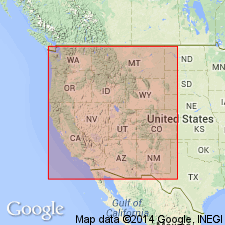
- Usage in publication:
-
- Niagara group
- Modifications:
-
- Original reference
- AAPG geologic province:
-
- Appalachian basin
Summary:
Pg. 52, 57-62. Niagara group. Includes Rochester shale and Lockport limestone, and rests on "Protean group" (green shales, Pentamerus limestone, and iron ores and = Clinton formation minus Rochester shale member).
Source: US geologic names lexicon (USGS Bull. 896, p. 1496).

- Usage in publication:
-
- Niagara group*
- Niagara period
- Niagara limestone*
- Niagara dolomite*
- Modifications:
-
- Overview
- AAPG geologic province:
-
- Appalachian basin
Summary:
Definition of Hall persisted for several decades, although J.D. Dana as far back as 1857 used Niagara period to include Niagara group, Clinton group (excluding Rochester shale member), Medina sandstone, and Oneida conglomerage [Oswego sandstone and not true Oneida, which is = upper Medina]; but Dana excluded "Galt limestone" [Guelph] at top. The 1863, 1864, 1868, 1869, 1875, and 1895 editions of his Textbook of geology employed the foregoing classification. In some early reports the Rochester shale was called "Niagara shale" and the Lockport dolomite was called "Niagara limestone." In 1898 (Buffalo Soc. Nat. Sci. Bull., v. 6, no. 1, p. xvii) A.W. Grabau applied Niagara group to all rocks between Onondaga group (as he called the middle Silurian) and Upper Ordovician. In 1899 (Sci., n.s., v. 10, p. 874-878) J.M. Clarke and C. Schuchert introduced Niagaran period or group to include Guelph dolomite, Lockport limestone, Rochester shale, and Clinton beds. This is present commonly accepted definition of Niagara group, although Rochester shale is now treated as a member of Clinton formation and the beds carrying the Guelph fauna are included in Lockport dolomite by the USGS and others. G.H. Chadwick's 1908 classification, however (Sci., n.s., v. 28, p. 346-348), also A.W. Grabau's 1909 classification (Jour. Geol., v. 17, p. 209-252), included "upper Medina" (Albion sandstone) in the Niagaran. In 1865 James Hall included the Guelph in Niagara group, and it is generally now included in that group, although the Canadian Geol. Survey (see M.Y. Williams 1914 and 1919) formerly excluded, and probably still excludes, the Guelph from the Niagara. In 1911 (GSA Bull., v. 22, p. 560-561) E.O. Ulrich stated that Brassfield limestone is oldest Clinton known, and he included it in his Niagaran series. Later, however, he correlated the Brassfield with Albion sandstone and excluded it from the Niagaran, as do other geologists. On pl. 28 of Bull, v. 22, cited above, Ulrich classified Louisville limestone of Kentucky as younger than the Guelph, but included it in his Niagaran series, as did R.S. Bassler, 1915 (U.S. Nat. Mus. Bull. 92, v. 2, pl. 4). Ulrich and Bassler, 1923 (Maryland Geol. Survey Sil. Vol. 37, p. 329, where he seems to correlate it with Guelph).
The Clinton formation of Niagara group is a distinct unit as far south as northeastern Tennessee. In Upper Mississippi Valley States the deposits of Niagara age are usually not divided, and are there called Niagara limestone or Niagara dolomite, depending upon the lithology.
Source: US geologic names lexicon (USGS Bull. 896, p. 1495-1496).
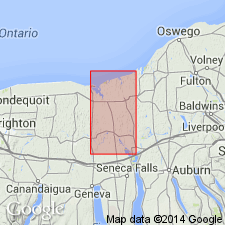
- Usage in publication:
-
- Niagara
- AAPG geologic province:
-
- Appalachian basin
Summary:
Pg. 26-101. From time of earliest State report, term Niagaran has been in every classification of New York Silurian, but its meaning has not been constant. At times it has been limited to a single formation such as Niagara limestone or Niagara shale. In other instances, it has been enlarged to include whole Silurian section from base of Queenston to lowest layers of the Salina. According to Silurian classification by Hall (1843), name Niagara should be used as group term covering formations from top of Clinton to base of Onondaga salt group. In this report, term Niagaran series is used to include Lockport dolomite above and Clinton group (includes strata from base of Thorold sandstone to top of Rochester shale). Formations consituting series are a well-marked lithologic unit of limestone and shales, which are distinct from Medinan sandstones above. Niagaran is represented by fossiliferous shales and limestone of normal marine period. Thus, Niagaran is a lithologic, a stratigraphic, and a faunal unit.
Source: US geologic names lexicon (USGS Bull. 1200, p. 2739-2740).
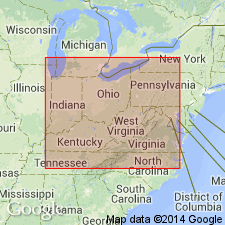
- Usage in publication:
-
- Niagaran
- AAPG geologic province:
-
- Appalachian basin
Summary:
Chart 3. Silurian comprises (ascending) Albion, Niagaran, and Cayugan series.
Source: US geologic names lexicon (USGS Bull. 1200, p. 2739-2740).
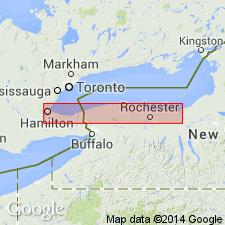
Summary:
Pg. 1979-1996. Silurian system exclusive of Cayugan divided into (ascending) Medina(n), Clinton(ian), and Niagara(n) groups, the three comprising the Ontarian series. In New York, the Niagaran group includes the Lockport and Guelph interval.
Source: US geologic names lexicon (USGS Bull. 1200, p. 2739-2740).
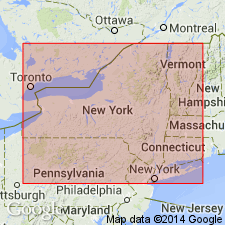
Summary:
New York Silurian, standard reference section for United States, is divided into two series Niagaran (older) and Cayugan. Niagaran series divided into four stages (ascending) Lewiston(ian), Ontario(an), Tonawanda(n), and Lockport(ian).
Source: US geologic names lexicon (USGS Bull. 1200, p. 2739-2740).
For more information, please contact Nancy Stamm, Geologic Names Committee Secretary.
Asterisk (*) indicates published by U.S. Geological Survey authors.
"No current usage" (†) implies that a name has been abandoned or has fallen into disuse. Former usage and, if known, replacement name given in parentheses ( ).
Slash (/) indicates name conflicts with nomenclatural guidelines (CSN, 1933; ACSN, 1961, 1970; NACSN, 1983, 2005, 2021). May be explained within brackets ([ ]).

